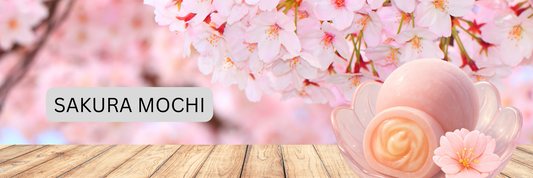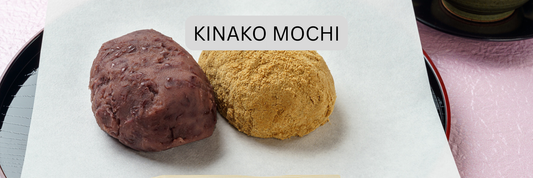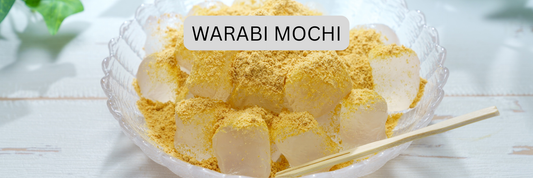When spring arrives in Japan, cherry blossoms bloom and the entire country celebrates the fleeting beauty of the season. Along with hanami (flower viewing), one sweet treat that perfectly captures this moment is Sakura Mochi (桜餅). This traditional Japanese wagashi is instantly recognizable: a delicate pink rice cake filled with sweet red bean paste (anko) and wrapped in a salt-pickled cherry blossom leaf.
In this guide, you’ll learn everything about Sakura Mochi – its history and cultural significance, the difference between Kanto and Kansai styles, how to make it at home with step-by-step recipes, variations, storage tips, nutrition, and answers to the most common FAQs.
-
Kinako Mochi: How to Make This Traditional Japanese Sweet at Home
-
Warabi Mochi: Japan’s Delicate Jelly Dessert You Must Try
-
Calories in Mochi: The Complete Guide to Nutrition, Health, and Low-Calorie Alternatives
What is Sakura Mochi?

Sakura Mochi (桜餅) is a traditional Japanese rice cake dessert that combines sweet, salty, and floral flavors. The pink mochi dough encases anko (sweet red bean paste) and is wrapped with a pickled sakura leaf (shio-zuke).
- Popular during Hinamatsuri (Girls’ Day on March 3) and hanami (cherry blossom viewing).
- A spring wagashi that symbolizes beauty and impermanence, much like cherry blossoms themselves.
History and Origin of Sakura Mochi

- Kanto Sakura Mochi (Chōmeiji style) was first made in Edo (Tokyo) in 1717 at Chōmeiji Temple, using salted cherry leaves from the temple grounds.
- Kansai Sakura Mochi (Dōmyōji style) originated in Osaka, made with domyoji rice (coarsely ground steamed glutinous rice).
- Over centuries, it became a nationwide spring sweet enjoyed at tea ceremonies, festivals, and homes.
Types of Sakura Mochi

Kanto Style (Chōmeiji Sakura Mochi)
- Uses shiratamako or mochiko (glutinous rice flour), sometimes wheat flour.
- Cooked like a thin pink crepe wrapped around anko.
- Smooth texture, often oval-shaped.
Kansai Style (Dōmyōji Sakura Mochi)
- Uses domyoji rice (domyoji-ko) for a chewy, grainy texture.
- Shaped into round balls filled with anko.
- Wrapped in salted sakura leaves.
Sakura Mochi Ingredients
To make Sakura Mochi, you’ll need:
- Glutinous rice flour (shiratamako, mochiko, or domyoji-ko)
- Sweet red bean paste (anko – koshian or tsubuan)
- Sugar, water, pinch of salt
- Pickled sakura leaves (shio-zuke sakura leaf)
Optional: sakura essence, beet powder for pink coloring, white bean paste, or matcha powder.
Sakura Mochi Recipe

Ingredients
- 100 g shiratamako (glutinous rice flour)
- 20 g wheat flour (optional, authentic style)
- 30 g sugar
- Water + pink coloring
- 100 g smooth anko (koshian)
- 6–8 salted sakura leaves
Method
- Mix flour, shiratamako, sugar, water into a thin batter.
- Cook crepes in a non-stick pan.
- Shape anko into oval balls.
- Wrap with crepe, then with sakura leaf.
- Serve with green tea.
Sakura Mochi Recipe – Kansai Style
Ingredients
- 100 g domyoji rice
- 30 g sugar
- 100 g anko (smooth or chunky)
- 6–8 sakura leaves
Method
- Soak domyoji rice for 30 minutes. Steam until tender.
- Mix with sugar and cool.
- Flatten rice, place anko inside, form into a ball.
- Wrap with sakura leaf and serve.
Types of Mochi: Complete Guide to Japanese Mochi Varieties
Pickled Sakura Leaves – The Secret Ingredient
- Made from Oshima cherry leaves preserved in salt.
- Adds a salty, floral aroma that balances sweetness.
- Edible or optional – some eat the leaf, others peel it away.
Variations and Modern Twists
- Matcha Sakura Mochi (green tea flavored)
- Strawberry or chocolate-filled sakura mochi
- Sakura mochi ice cream, cakes, daifuku
- Vegan and gluten-free adaptations
How to Serve Sakura Mochi
- Pair with matcha, sencha, hojicha, or genmaicha.
- Popular during tea ceremonies, hanami picnics, and spring parties.
- Presentation tip: serve on lacquer trays with sakura blossoms.
Nutrition and Storage
- Calories: 120–150 kcal each.
- Mostly carbs, low fat, vegan-friendly (unless wheat is added).
- Storage:
- Fresh is best.
- Refrigerate up to 2 days (airtight).
- Freeze up to 1 month.
Sakura Mochi FAQ
Is the sakura leaf edible?
Yes – it’s edible and enhances flavor, but optional.
What’s the difference between Sakura Mochi and Kashiwa Mochi?
- Sakura Mochi: spring, cherry leaves, Girls’ Day.
- Kashiwa Mochi: oak leaves, Children’s Day in May.
How long does Sakura Mochi last?
Eat fresh; refrigerate 1–2 days, freeze up to 1 month.
Is Sakura Mochi gluten-free?
Kansai style is gluten-free. Kanto style may contain wheat.
Can I make Sakura Mochi without leaves?
Yes – use sakura essence or powder instead, though the leaf is iconic.
Conclusion
Sakura Mochi is more than just a dessert – it’s a cultural experience that reflects Japan’s love for cherry blossoms and seasonal traditions. Whether you prefer the smooth Kanto crepe-style or the chewy Kansai domyoji-style, this springtime wagashi is a must-try.
Why not try making Sakura Mochi at home this season, or find it at your nearest Japanese confectionery shop? Pair it with matcha, and you’ll have a true taste of Japanese spring.







